Table of Contents
- Editor’s Choice
- Telecom API Market Statistics
- Regional Analysis of the Global Telecom API Market
- Types of Telecom API Statistics
- History of Telecom APIs
- Telecom API Used in Production Statistics
- Public Telecom API in Use Statistics
- Areas where API Developers Work Worldwide
- Most Exciting Technologies for People Working with (APIs)
- Time Allocation of API Tasks Worldwide
- Top IT Priorities for Telecom Providers
- Telecom API IT Spending Across Various Departments Statistics
- Overall API Breakages and Changes Worldwide
- New Developments in Telecom API Statistics
- Recent Developments
- Conclusion
- FAQs
Telecom API Statistics: Telecom APIs are fundamental tools for integrating telecommunications functionalities into software applications, enabling developers to incorporate features like voice calling, messaging, and data services.
These APIs come in various types, including Voice, Messaging, Data, Authentication, Payment, and Location APIs, catering to different communication needs.
Common applications include unified communications, IoT device management, customer engagement, mobile marketing, and AI in telecom service provisioning.
Protocols such as REST, SOAP, and WebRTC are utilized for API implementation, with considerations for security, scalability, regulatory compliance, and quality of service.
Overall, Telecom APIs empower developers to build innovative solutions that leverage the capabilities of telecommunication networks, enhancing communication experiences across diverse industries.
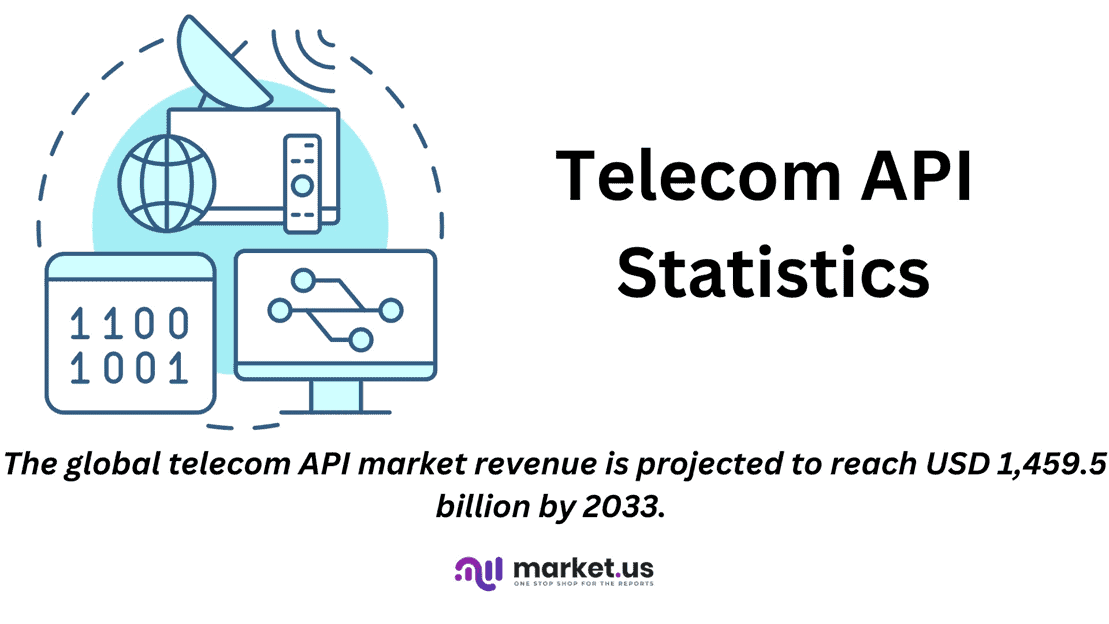
Editor’s Choice
- The global telecom API market revenue is projected to reach USD 1,459.5 billion by 2033.
- In the global telecom API market, Google LLC leads with an 18% market share.
- The global telecom API market is distributed across various regions, with North America leading with a 30.0% market share.
- The number of public telecom APIs in use reached 16,061 in 2016.
- In 2020, professionals working with application programming interfaces (APIs) identified several technologies as particularly exciting. Microservices topped the list, with 48.70% of respondents showing interest.
- In 2020, the time allocation for various application programming interface (API) tasks worldwide showed a diverse distribution of focus areas. The largest portion of time, 29.5%, was dedicated to coding and programming APIs, indicating the primary role of development in API-related activities.
- In telecom IT spending, the operations department received the highest allocation, with 28% of respondents indicating it as a primary focus, reflecting the critical need to maintain and enhance network infrastructure and service delivery.

Telecom API Market Statistics
Global Telecom API Market Size Statistics
- The global telecom API market has shown significant growth over the past years and is projected to continue its upward trajectory at a CAGR of 18.1%.
- In 2023, the market revenue was recorded at USD 276.5 billion.
- This figure is expected to rise to USD 326.5 billion in 2024 and further to USD 385.7 billion in 2025.
- By 2026, the market is anticipated to reach USD 455.5 billion, followed by USD 537.9 billion in 2027.
- The growth trend continues, with the market expected to hit USD 635.2 billion in 2028 and USD 750.2 billion in 2029.
- Looking ahead, projections for 2030 indicate a substantial increase to USD 886.0 billion, reaching USD 1,046.4 billion by 2031.
- By 2032, the market is forecasted to grow to USD 1,235.8 billion, and by 2033, it is expected to achieve a remarkable USD 1,459.5 billion.
- This consistent growth underscores the expanding role of telecom APIs in the global market.
(Source: market.us)
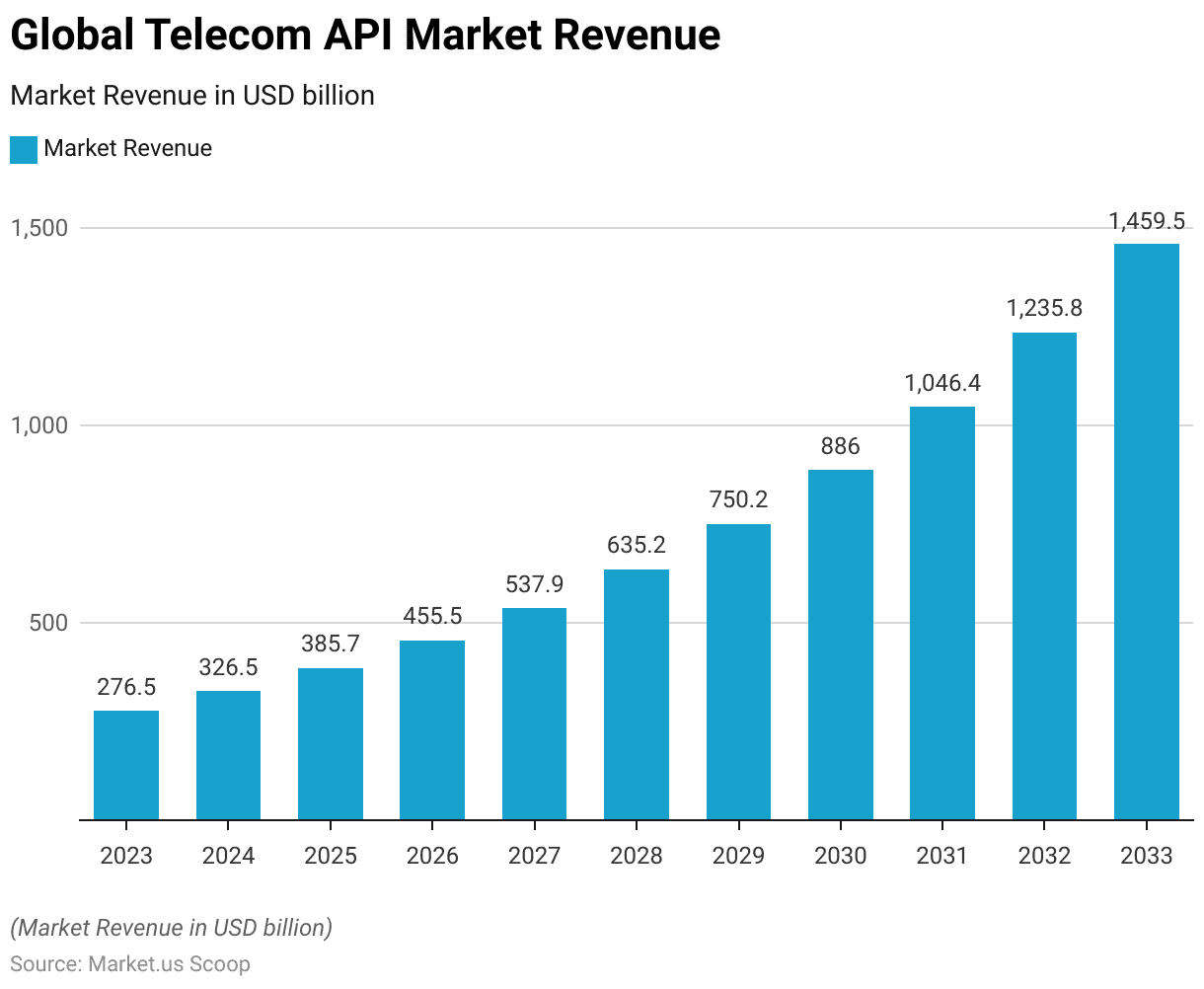
Competitive Landscape of the Global Telecom API Market
- In the global telecom API market, several key players hold significant market shares.
- Google LLC leads with an 18% market share, followed closely by AT&T, Inc. with 17%.
- Verizon Communication, Inc. and Telefonica S.A. each account for 9% and 8% of the market share, respectively.
- Similarly, Twilio Inc. holds an 8% share, while Apigee Corp. and Alcatel-Lucent each capture 7% and 6% of the market, respectively.
- Orange also maintains a 6% market share.
- The remaining 22% of the market is occupied by other key players, highlighting a diverse and competitive landscape within the telecom API sector.
(Source: market.us)
Take advantage of our unbeatable offer - buy now!

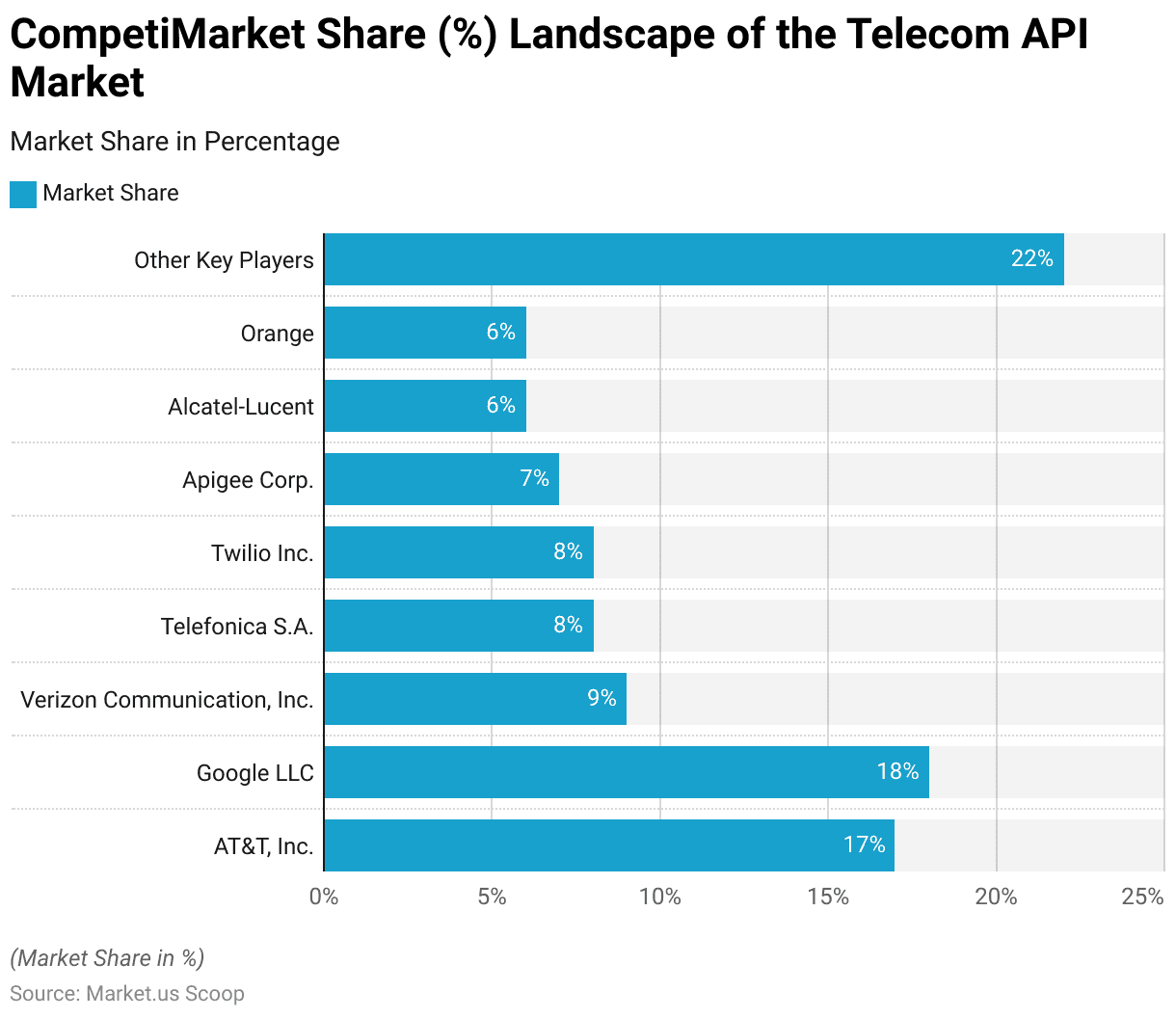
Regional Analysis of the Global Telecom API Market
- The global telecom API market is distributed across various regions, with North America leading with a 30.0% market share.
- The Asia-Pacific (APAC) region follows closely with a 27.5% share, indicating significant market activity and growth potential.
- Europe holds a 27.0% share, reflecting its strong position in the market.
- South America accounts for 11.0% of the market, while the Middle East and Africa (MEA) region holds a 4.5% share.
- This regional distribution highlights the global reach and diverse growth opportunities within the telecom API market.
(Source: market.us)
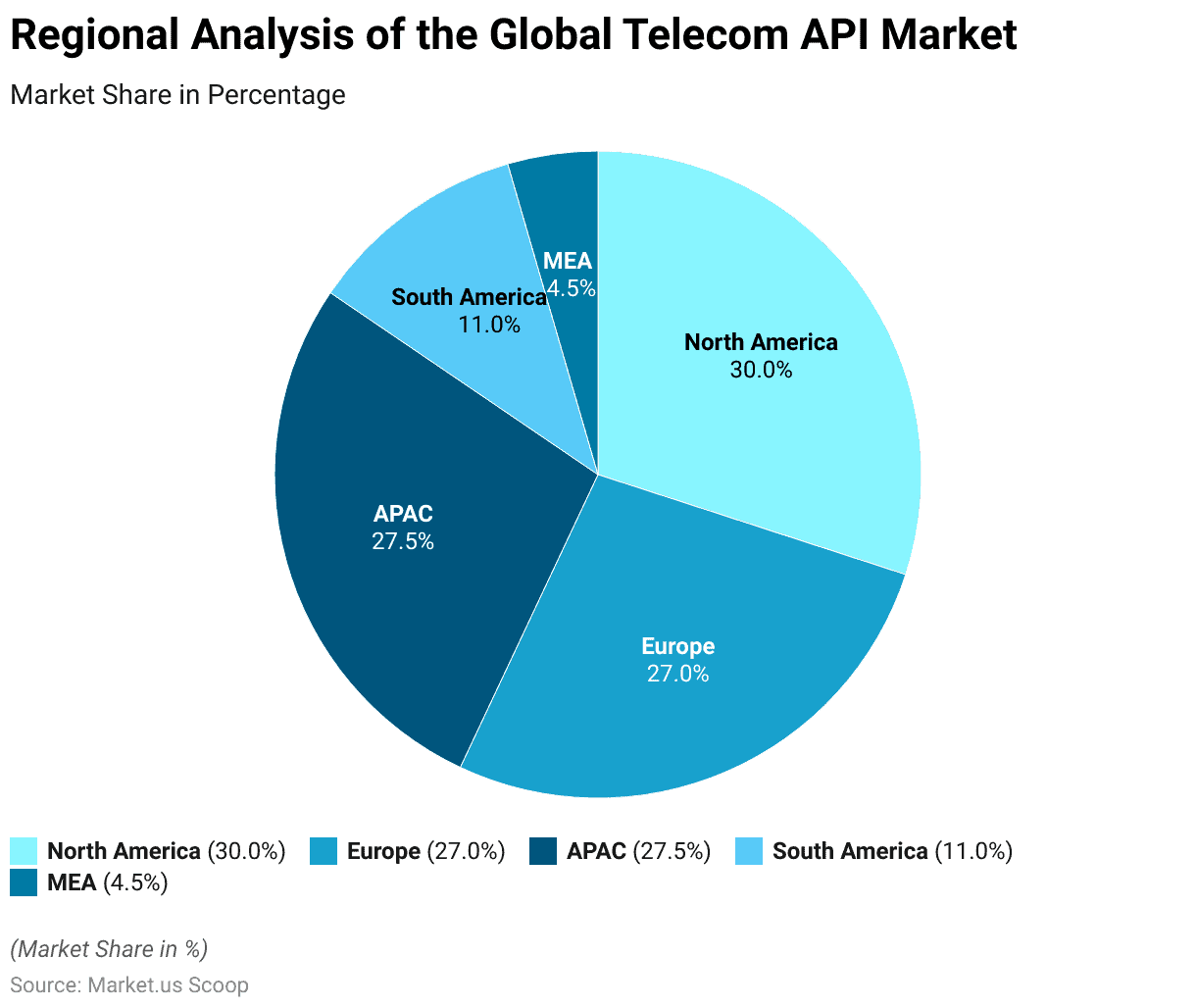
Types of Telecom API Statistics
- The telecom API market encompasses various types of APIs that facilitate diverse functionalities and services.
- Notable types include Messaging APIs, which dominate the market and enable SMS, MMS, and RCS messaging services.
- WebRTC APIs support real-time communication capabilities, such as video and voice calls, directly within web browsers without the need for additional plugins.
- Payment APIs facilitate secure online transactions, while IVR/Voice Control APIs are used for interactive voice response systems, automating customer interactions through voice commands.
- Location and Map APIs provide geolocation services essential for apps requiring real-time location tracking and mapping.
- Subscriber Identity Management APIs ensure secure API management of user identities and Single Sign-On (SSO) functionalities.
(Source: market.us)
History of Telecom APIs
- The history of telecom APIs has evolved significantly over the past few decades, shaping the digital landscape.
- Initially, in the 1990s, APIs began as a method for applications to exchange data across systems, primarily within organizations.
- The early 2000s marked a significant shift, with Salesforce launching the first enterprise-class web-based API in 2000, facilitating easier data sharing across applications.
- This period also saw eBay and Amazon release their APIs, catalyzing the growth of web services and cloud computing.
- By 2006, the introduction of social media APIs by platforms like Twitter and Facebook revolutionized how APIs were used, leading to the development of numerous third-party applications.
- The 2010s further advanced API technology with the rise of RESTful APIs, which simplified web interactions and became the backbone of modern web services.
- Today, telecom APIs are integral to enabling real-time communication, IoT connectivity, and advanced cloud-based services, contributing to a market projected to reach USD 1,459.5 billion by 2033.
(Sources: Traefik, Treblle, Postman, Readme, Connection Café)
Telecom API Used in Production Statistics
- The usage of various telecom APIs has seen notable increases from 2021 to 2022, reflecting their growing adoption in production environments.
- REST APIs experienced the highest increase, with a 69.3% rise, underscoring their continued dominance in facilitating web interactions.
- Webhooks followed with a 34.6% increase, driven by their efficiency in enabling real-time notifications and data updates.
- WebSockets saw a 29.5% rise, enhancing full-duplex communication channels for real-time applications.
- AsyncAPI usage grew by 26.5%, highlighting its role in supporting asynchronous communication. Serverless and Function-as-a-Service (FaaS) APIs increased by 25.4%, reflecting the shift towards scalable and cost-efficient cloud solutions.
- SOAP APIs, despite being older, still saw a 23% increase due to their robustness in enterprise environments.
- GraphQL APIs rose by 18.6%, favored for their flexibility in querying data.
- Finally, gRPC APIs experienced an 8% increase, enhancing performance through efficient binary protocols.
(Source: Treblle)
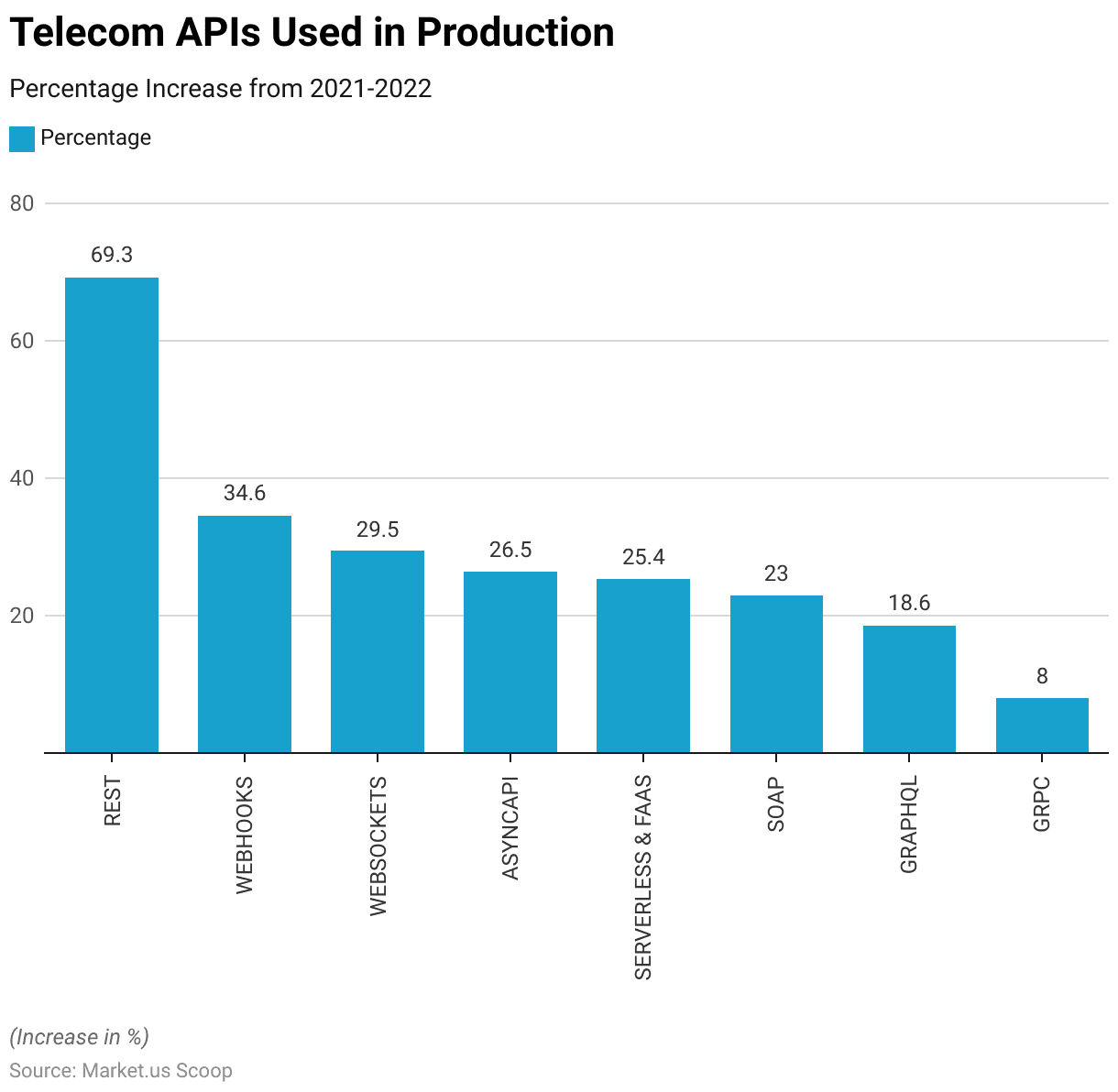
Public Telecom API in Use Statistics
- The number of public telecom APIs in use has shown significant growth from 2006 to 2016.
- In 2006, there were 299 public telecom APIs, which nearly doubled to 593 by 2007.
- This upward trend continued with 865 APIs in 2008 and a substantial increase to 1,546 APIs in 2009.
- The year 2010 saw the number rise to 2,418 APIs, followed by 3,422 in 2011.
- The growth accelerated dramatically in 2012, reaching 7,182 APIs, and continued to 10,302 in 2013.
- By 2014, the number of public telecom APIs grew to 12,649, increasing further to 14,600 in 2015 and reaching 16,061 in 2016.
- This consistent increase highlights the expanding role and adoption of APIs in the telecom industry over the decade.
(Source: Readme)
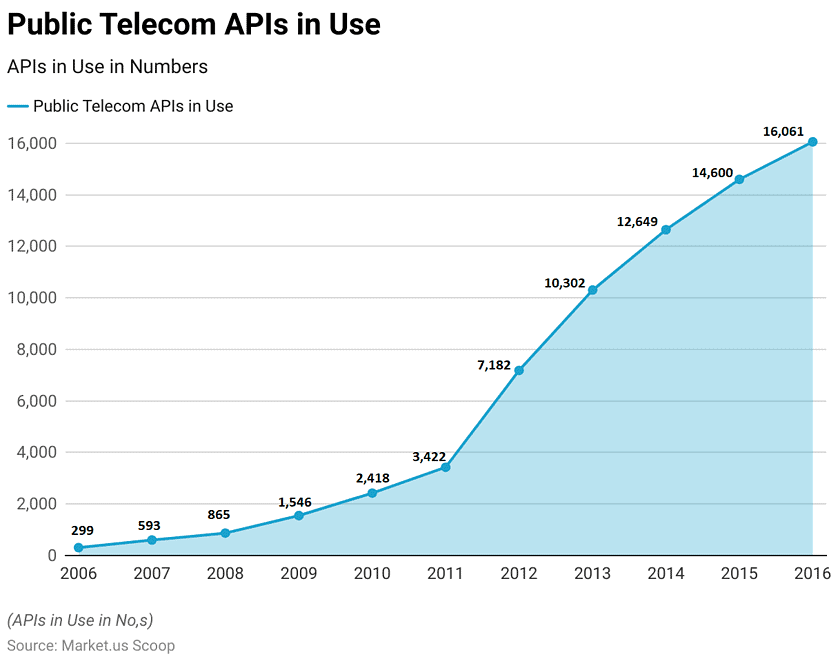
Areas where API Developers Work Worldwide
- As of 2022, application programming interface (API) developers are engaged in various roles across the tech industry.
- The largest group, comprising 25% of respondents, works as full-stack developers, handling both front-end and back-end development.
- Backend developers represent 19%, focusing on server-side applications.
- Quality engineers make up 9%, ensuring the software meets specified requirements.
- Front-end developers account for 5%, specializing in user interface design.
- Technical or solutions architects and directors or managers each constitute 4%, overseeing system designs and project management, respectively.
- Integration engineers, DevOps engineers, students/professors, data engineers/analysts, and product managers each represent 3%.
- Chief Technology Officers (CTOs), business analysts, and mobile developers each hold 2% of the roles.
- Support/customer success teams, Chief Executive Officers (CEOs), sales/solutions engineers, network engineers, security engineers, and Vice Presidents (VPs) of engineering each account for 1%.
- An additional 5% fall into various other categories, reflecting the diverse opportunities available for API developers globally.
(Source: Statista)

Most Exciting Technologies for People Working with (APIs)
- In 2020, professionals working with application programming interfaces (APIs) identified several technologies as particularly exciting.
- Microservices topped the list, with 48.70% of respondents showing interest and highlighting their importance in building scalable and modular applications.
- Kubernetes, with a 43.60% share, was noted for its role in automating the deployment, scaling, and management of containerized applications.
- Closely following, containers garnered 42.20% interest, reflecting their utility in creating consistent development environments.
- Serverless architecture was exciting to 39% of respondents, and it was appreciated for its ability to run code without managing servers.
- GraphQL attracted 33.40% of respondents due to its efficient data querying capabilities.
- HTTP/2 and event-driven architectures were exciting for 24.70% and 24.10% of respondents, respectively, for their improvements in performance and responsiveness.
- Pub/sub-systems, known for enabling scalable and decoupled communication, interested 17.40% of respondents.
- Lastly, service mesh technology was noted by 9.90% of respondents, which is valued for managing service-to-service communication within microservices architectures.
(Source: Statista)

Time Allocation of API Tasks Worldwide
- In 2020, the time allocation for various application programming interface (API) tasks worldwide showed a diverse distribution of focus areas.
- The largest portion of time, 29.5%, was dedicated to coding and programming APIs, indicating the primary role of development in API-related activities.
- Debugging and manual testing accounted for 17%, reflecting the importance of ensuring API functionality and reliability.
- Automated testing was allocated 10.8%, highlighting efforts to streamline the testing process.
- Designing and mocking APIs received 8.7%, focusing on the initial planning and simulation of API functionality.
- API documentation accounted for 6.1%, which is essential for guiding developers and users. Managing others who use APIs was 5.8%, and meetings about APIs took up 5.7%, indicating significant collaboration and oversight efforts.
- Collaborating on APIs was allocated 4.9%, showing the emphasis on teamwork. API monitoring accounted for 4.3%, ensuring ongoing performance and reliability.
- Both publishing APIs and managing API articles each received 2.5%, focusing on deployment and informational resources.
- Lastly, writing about APIs took up 2.2%, underscoring the need for educational and promotional content.
(Source: Statista)
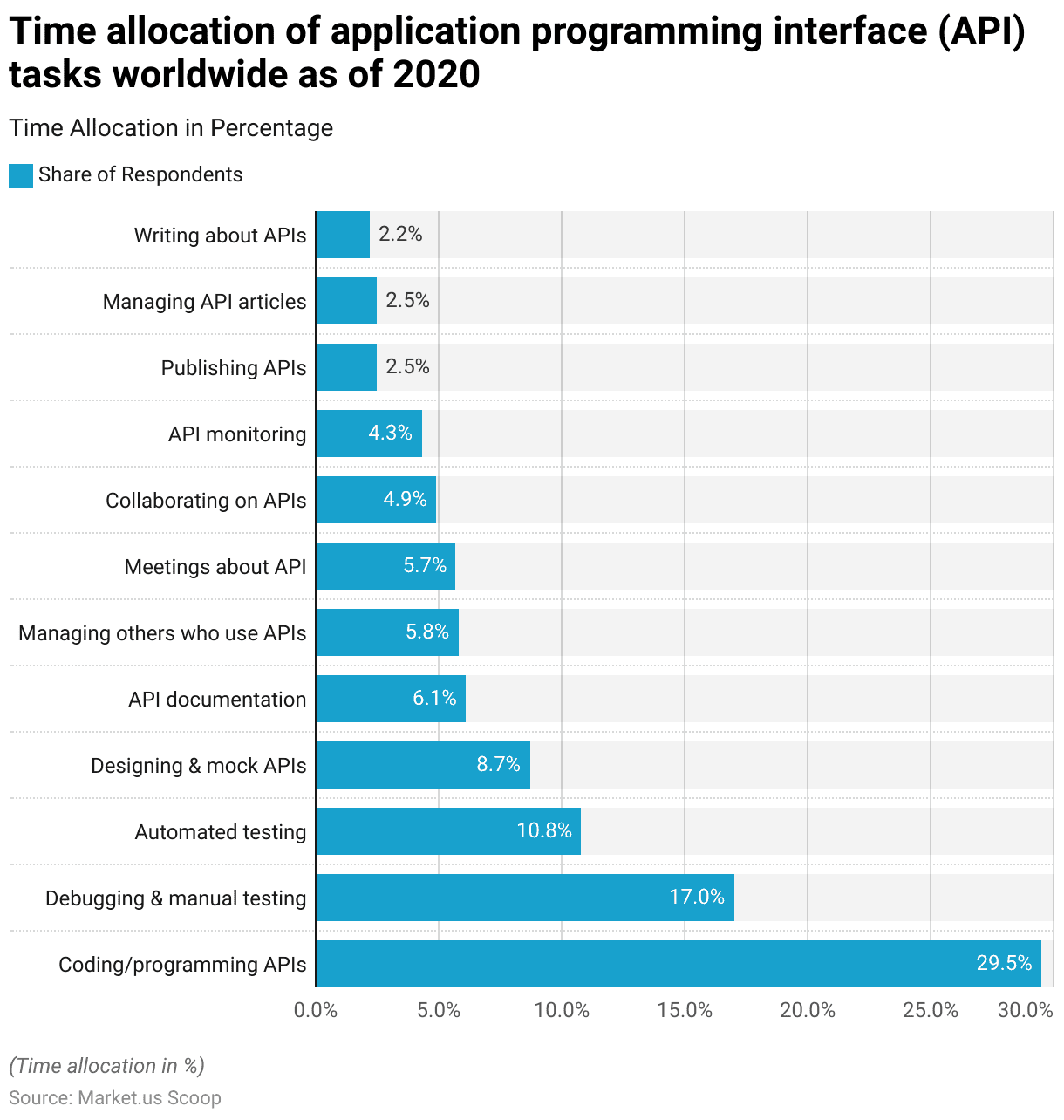
Top IT Priorities for Telecom Providers
- In 2020, telecom providers identified several key IT priorities.
- Leading the list was managing security, identity, and privacy, with 23% of respondents emphasizing its importance in safeguarding data and maintaining user trust.
- Creating digital capability was the second-highest priority at 18%, reflecting the need to enhance digital services and infrastructure.
- Building the modern workplace was prioritized by 16%, focusing on enabling flexible and efficient working environments.
- Modernizing legacy systems was a priority for 14% of respondents, highlighting the need to upgrade outdated technology.
- Adopting cloud services was important for 11%, facilitating scalability and efficiency.
- Intelligent automation and artificial intelligence were a focus for 8%, aiming to enhance operational efficiency and service delivery.
- Exploiting business information for insights was a priority for 3% of respondents, alongside connecting the physical world through the Internet of Things (IoT).
- Transforming customer experience, building a digital ecosystem, and improving IT sustainability each garnered 2% of the focus, reflecting a broader strategy to enhance overall service quality and sustainability.
(Source: Oracle)
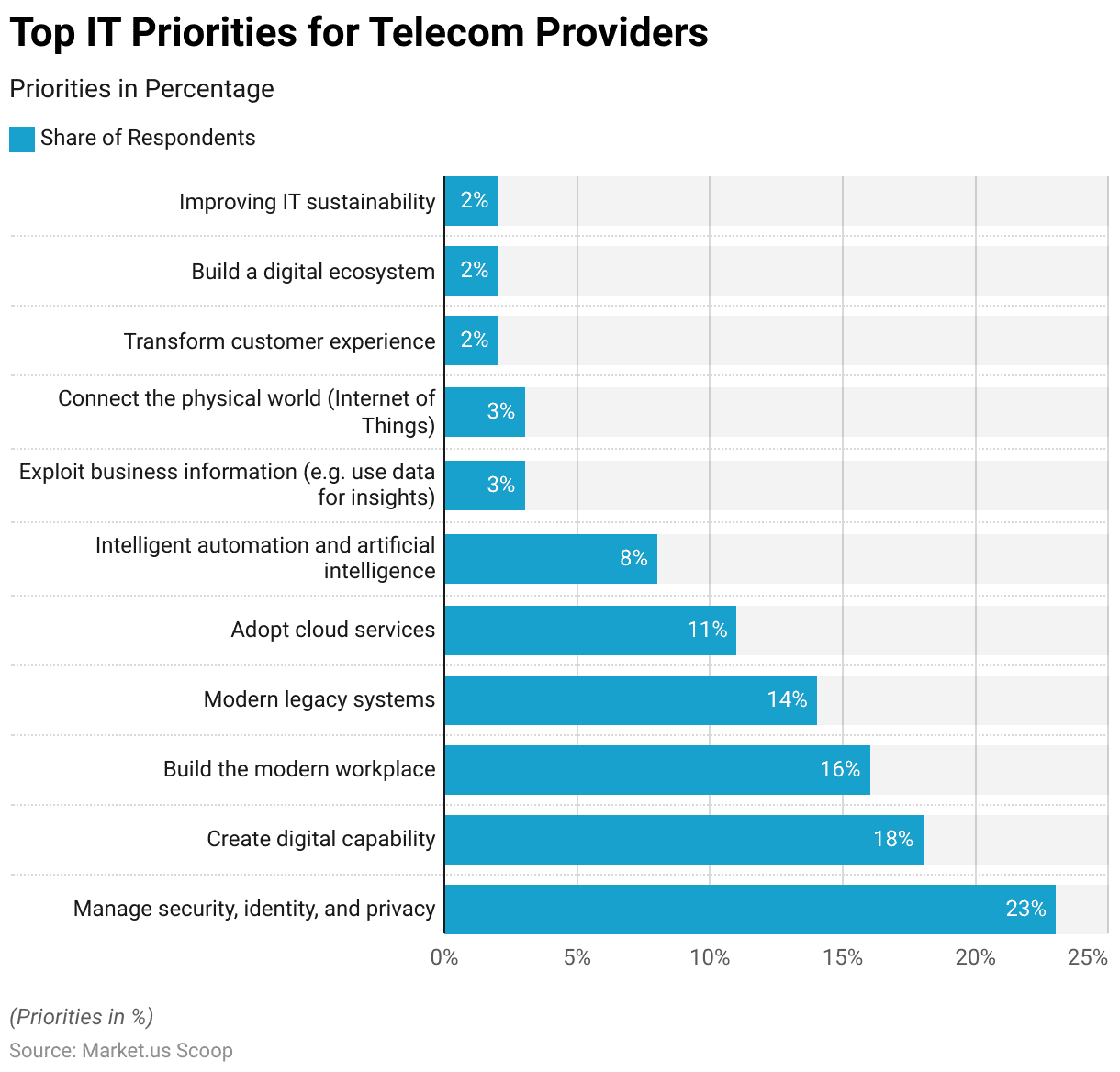
Telecom API IT Spending Across Various Departments Statistics
- In telecom IT spending, the operations department received the highest allocation, with 28% of respondents indicating it as a primary focus, reflecting the critical need to maintain and enhance network infrastructure and service delivery.
- Sales and distribution closely followed, accounting for 27% of the spending, emphasizing the importance of supporting sales channels and customer acquisition strategies.
- The marketing – CMO office was allocated 25%, highlighting efforts to drive market growth and brand positioning.
- Research and development (R&D) garnered 11% of the spending, underscoring the commitment to innovation and technological advancement.
- The finance and accounting – CFO office received 7%, focusing on financial management and planning.
- Lastly, the human resources department was allocated 2%, indicating a smaller, yet vital, investment in managing workforce capabilities and development.
(Source: Oracle)
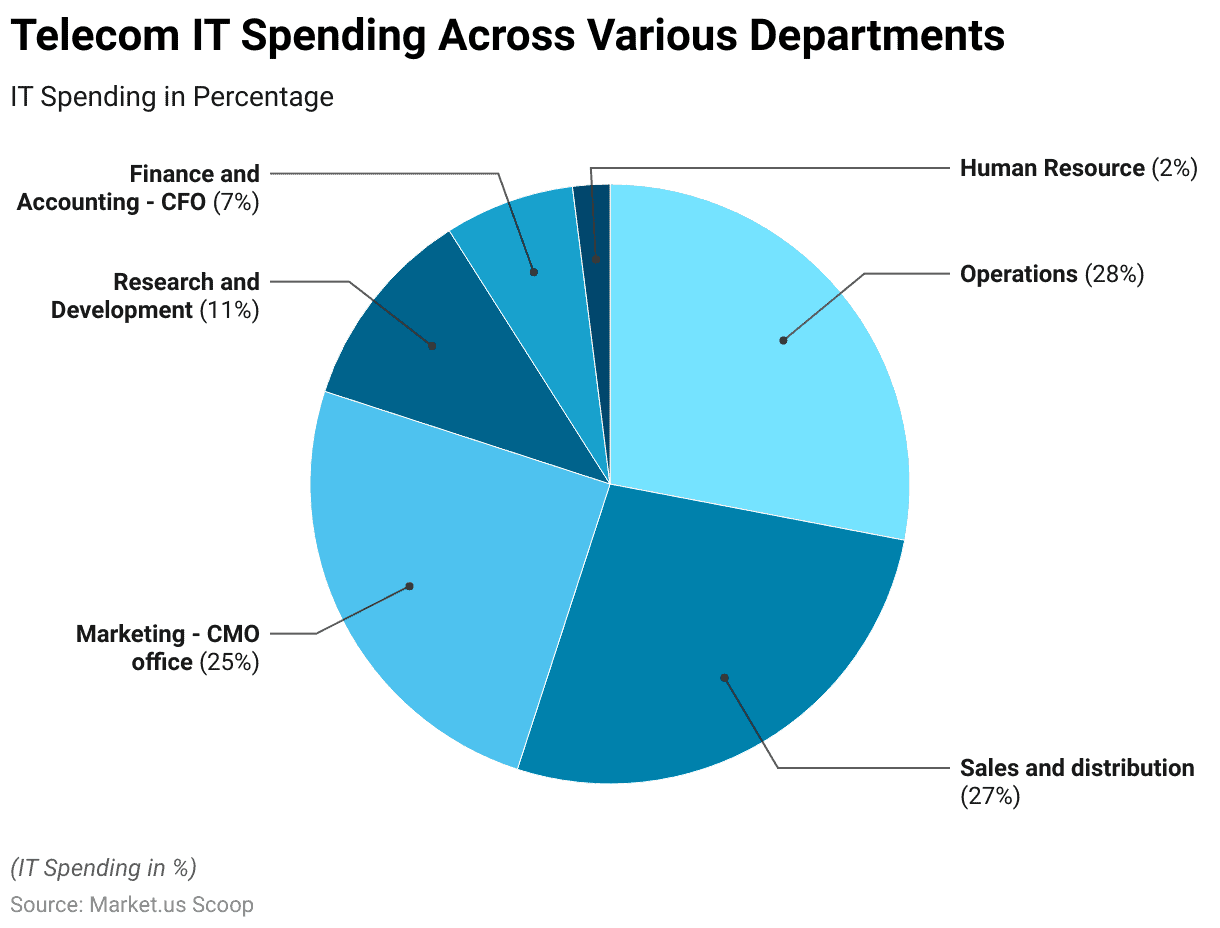
Overall API Breakages and Changes Worldwide
- In 2020, the frequency of application programming interface (API) breakages and changes varied by API category.
- For internal APIs, 55.8% of respondents reported that breakages occurred “not enough to matter,” while 22.9% experienced monthly disruptions.
- Weekly breakages were noted by 9.1%, with 9.9% indicating that changes happened too frequently and 2.2% reporting daily issues.
- External APIs showed a slightly higher stability, with 60.4% of respondents indicating negligible breakages.
- Monthly changes were experienced by 20.9%, weekly by 6%, too frequent changes by 11%, and daily disruptions by 1.7%.
- For partner APIs, 61.2% of respondents reported infrequent breakages, 19.8% saw monthly changes, 5.8% experienced weekly issues, 11.6% reported too frequent changes, and 1.6% encountered daily disruptions.
- This data highlights that while the majority of APIs are stable, a significant proportion still face regular changes, impacting development and integration efforts.
(Source: Statista)
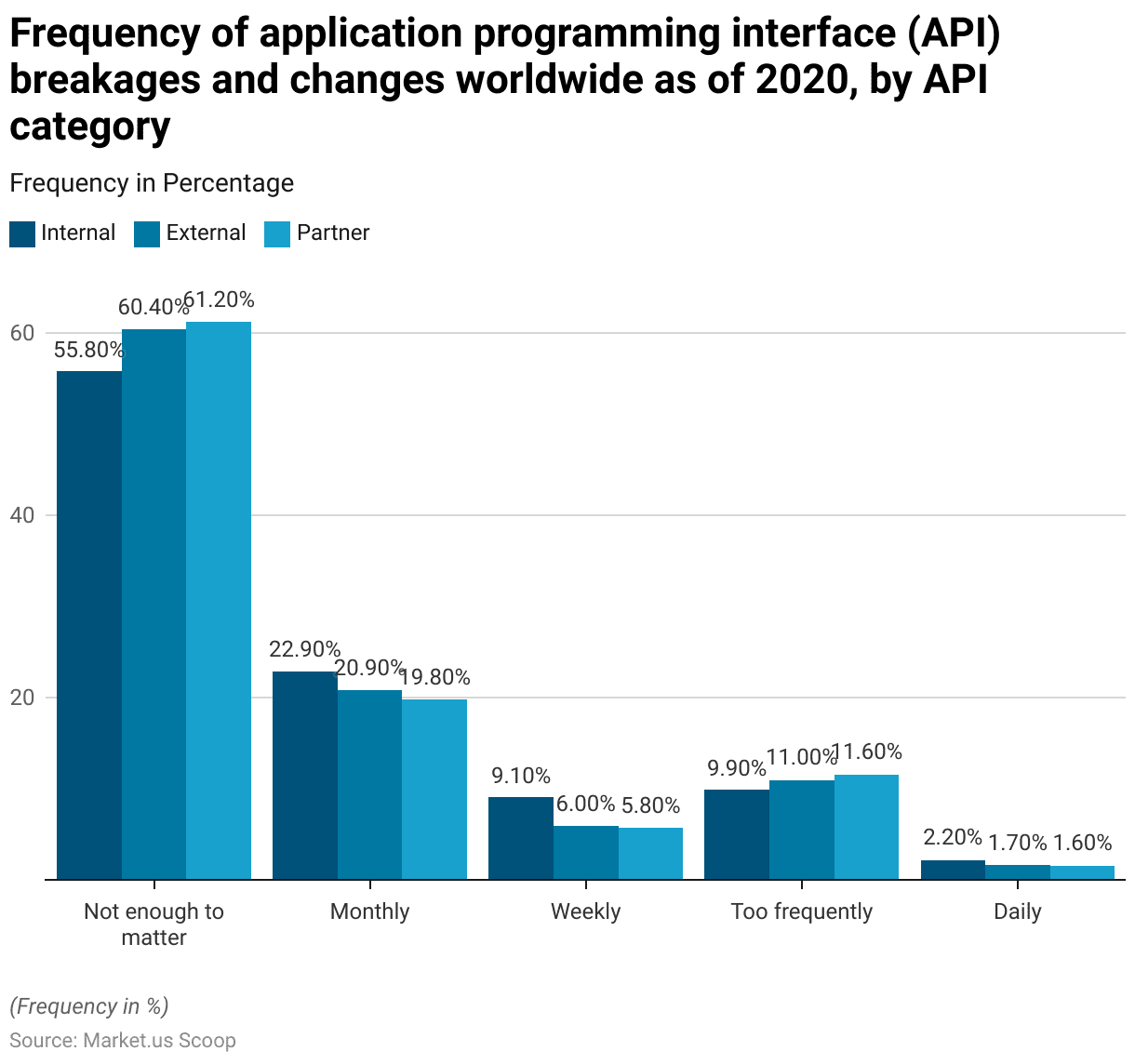
New Developments in Telecom API Statistics
- In 2024, several significant developments have emerged in the telecom API sector.
- A notable advancement is the increased adoption of network APIs, driven by initiatives like GSMA’s Open Gateway, which aims to standardize APIs across the industry. This effort is crucial for enhancing interoperability and enabling seamless integration of services across different networks.
- Additionally, the collaboration between major telecom companies and tech giants such as AWS, Verizon, and AT&T to develop and deploy network APIs is fostering innovative applications in areas like live media production and 5G-enabled vehicles.
- These APIs are set to unlock significant revenue opportunities, estimated to range between $100 billion to $300 billion in connectivity and edge-computing-related services over the next few years.
- The focus is also on performance-based business models, leveraging network APIs to provide advanced features and optimize costs, especially for enterprise customers.
- These developments highlight the ongoing evolution of telecom APIs as a critical component in the digital transformation of the telecommunications industry.
(Sources: Mckinsey, the New Stack, Ericsson)
Recent Developments
Acquisition:
- Infobip’s Acquisition of OpenMarket: Infobip, a global cloud communications platform, acquired OpenMarket, a leading mobile messaging provider, for $300 million. This acquisition strengthens Infobip’s position in the Telecom API market and expands its capabilities in mobile messaging services.
New Product Launches:
- Vodafone’s Network API for Call Notifications: In September 2023, Vodafone launched a new network API that provides banks, hospitals, and schools with the ability to notify smartphone users about incoming call identities. This service enhances communication efficiency and security for critical sectors.
- Ericsson and Deutsche Telekom’s Communication APIs: Ericsson partnered with Deutsche Telekom to offer commercial communication and network APIs to developers and enterprises. This initiative, announced in September 2023, aims to foster innovation and streamline the development of new telecom solutions.
Funding:
- Twilio’s Continued Investment in AI Integration: Twilio, a leading cloud communications platform, secured additional funding to enhance its APIs with AI capabilities.
- This investment aims to make APIs smarter and more efficient for automating tasks and personalizing communications.
Market Growth:
- This growth is driven by the increasing adoption of IoT devices, advancements in 5G technology, and the rising demand for mobile data and digital communication.
Innovation in Telecom API Technologies:
- Development of APIs for 5G Networks: In October 2023, new APIs for 5G network access were developed, enabling faster internet speeds and supporting innovative applications like real-time video streaming and connected cars.
- These advancements are expected to revolutionize various sectors, including entertainment and transportation.
Strategic Partnerships:
- Telefonica and Microsoft’s Collaboration on Programmable Networks: In February 2023, Telefonica extended its collaboration with Microsoft to include programmable networks through APIs, as part of the GSMA Open Gateway initiative.
- This partnership aims to provide universal access to telecom and network capabilities for developers and enterprises.
Conclusion
Telecom API Statistics – The telecom API sector has seen significant changes, becoming crucial for advanced communication services and innovation in telecommunications.
Initiatives like the GSMA’s Open Gateway are standardizing network APIs, improving interoperability, and simplifying service integration across networks.
Collaboration among telecom operators and tech firms is driving API deployment, unlocking revenue opportunities in connectivity and edge computing.
These advancements enable performance-based business models, benefiting enterprise customers. Telecom APIs are set to play a key role in the industry’s digital transformation and future growth.
FAQs
Telecom APIs are application programming interfaces that enable developers to integrate telecommunications functionalities such as voice, messaging, and data services into their applications. These APIs facilitate communication between different software systems and telecom networks.
Benefits include enhanced scalability, flexibility, and efficiency in integrating telecom services into applications. They allow for the rapid deployment of features like voice calls, SMS, and real-time data processing, improving customer engagement and operational workflows.
Network APIs specifically allow developers to access and control network functions directly, such as quality of service, network slicing, and location services. This differs from traditional telecom APIs, which typically focus on application-level services like messaging and voice.
The GSMA’s Open Gateway initiative aims to standardize network APIs across the telecom industry, enhancing interoperability and simplifying the integration of telecom services globally. This initiative is expected to boost innovation and facilitate the development of new services.
Common use cases include enabling VoIP services, SMS and MMS messaging, real-time data streaming, fraud detection through location verification, and integrating communication capabilities into enterprise applications.
Discuss your needs with our analyst
Please share your requirements with more details so our analyst can check if they can solve your problem(s)



